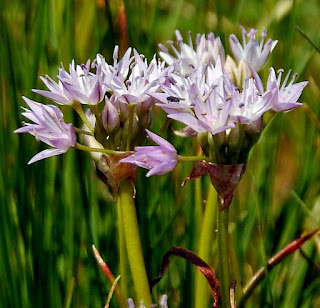This past Tuesday, June 6th, Sierra County opened the Gold Lake Road! Yahoo! It had been closed since last December!!! My friend Nancy and I decided to go up and check out what the trail conditions were like at the Lakes Basin Campground. When we got there the road into the campground hadn't been plowed, and still had a little more than a foot of snow on it. So we hiked through the campground to the Grassy Lake trailhead.
We were hoping to get up to Long Lake. In the forest the trail was about half bare ground and half snow covered. When we got up to the sunny steep slopes below Long Lake, there were LARGE areas of packed slippery snow and the trail was obscured. The day had started out with clear blue skies, but by 11:30 am the clouds started moving in and the sky darkened quite a bit!
We got about half a mile from Long Lake, but we didn't make it. A huge bank of super dark storm clouds came in, along with thunder and lightning, so we opted to try again another day and headed back down the trail.
Long Lake - June 8, 2017
Long Lake - June 8, 2017
Snow Plant - Sarcodes sanguinea
On the way up to Long Lake we were delighted to find some wildflowers in bloom along the trail! The Snow Plant pictured above was a welcome, familiar sight! It is one of the first flowers to bloom as the snow melts. We also saw several others that were just starting to emerge. Snow plants grow in the thick humus of montane coniferous forests from 4000' to 8000', often under pines, blooming from May to July. It supplements its nutrient intake by parasitizing the roots of pine trees by means of a shared mycorrhizal fungus.
Wikipedia states; "Snow Plant is a parasitic plant that derives sustenance and nutrients from mycorrhizal fungi that attach to tree roots. Lacking chlorophyll, it is unable to photosynthesize. Ectomicorrhizal symbioses involve a mutualism between a plant root and a fungus; the plant provides fixed carbon to the fungus and in return, the fungus provides mineral nutrients, water and protection from pathogens to the plant. The snow plant takes advantage of this mutualism by tapping into the network and stealing sugars from the photosynthetic partner by way of the fungus. This is known as mycoheterotrophy. The snow plant is host-specific and can only form relationships with the ectomycorrhizal basidiomycete Rhizopogon ellenae (false truffle)."
Spreading Phlox - Fawn Lily - Mahala Mat
Plox diffusa - Erythronium purpurascens - Ceanothus prostratus
In the sunny areas Spreading Phlox and Mahala Mat were blooming. These beautiful plants create lovely lavendar-purple carpets on the forest floor. The phlox has a heavenly fragrance, and the Mahala Mat is unbelievable when you look at it with a hand lens! In the damper, shadier areas we saw many Fawn Lily buds just emerging, and a few stalks in full bloom!
Sierra Buttes - 6/7/23
By the time we got back down to our car and started driving home, the dark clouds had spread out and turned white! Such beauty! It was a wonderful first day back in the Lakes Basin, our home away from home!
View north from the Steel Bridge - 5/31/23
Sierra Valley Again!
About three weeks ago my husband and I re-visited Sierra Valley. I also went there with my friends Rod and Rochelle just a week ago! I can't seem to stay away! It was absolutely gorgeous both times. The water is dropping, and the cows are in the fields now, but the waterfowl aren't as numerous as in the past. There were however, lots of wildflowers! Here's photos of some of the birds and blossoms we saw!
Redhead (female-male) - Aythya americana
American Coot - Fulica americana
I didn't know that an American Coot's feet were so BIG!!!
Ruddy Duck (male) - Oxyura jamaicensis
This brightly colored male was displaying for a female that was out of sight in the tules!
Barn Swallow - Hirundo rustica
Sandhill Crane - Antigone canadensis
Savannah Sparrow - Passeculus sandwichensis
White-faced Ibis - Plegadis chihi
Yellow-headed Blackbird on Yellow Pond-lilies
Xanthocephalus xanthocephalus - Nuphar lutea ssp. polysepala
This year there are more Western Blue Flag Iris blooming than ever before! We saw several huge patches of them out in the fields.
Western Blue Flag Iris - Sandhill Crane
Iris missouriensis - Antigone canadensis
In one of them a Sandhill Crane was foraging! Wow!!!
Western Blue Flag Iris - Iris missouriensis
Mt. Beckwourth and wild onions - Allium sp.
There were also lots and lots of wild onions in patches throughout the wetlands!
Wild Onions (unknown) - Allium sp.
Big, fat, pink clovers were also growing in abundance!
Beckwith's Clover - Trifolium beckwithii
Larkspur (unknown) - Delphinium sp.
View north near the Steel Bridge
I was mesmerized by the cumulonimbus clouds and blue sky, and their amazing reflections in the wetlands. Such incredible beauty! I know I'll be back soon!
What kind of insects are out and about?
Are the birds building nests or nesting now?
Check back next week for the answers to these questions and more!
Your questions and comments are greatly appreciated. Please feel free to email me at northyubanaturalist@gmail.com. Thanks!.


























No comments:
Post a Comment